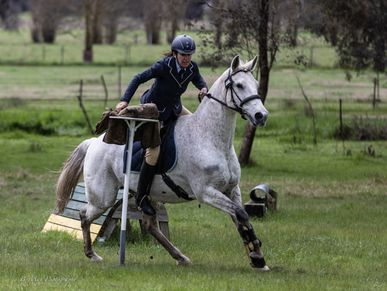Australian Obstacles
Varied Footing
Varied Footing

Specifications:
The obstacle should be 2.4 x 3 m minimum, with entrance flags and exit flags. Allowable types of footing may include horse float grade non-slip rubber matting, carpet, artificial grass, shavings, sands of different colours, mulch, wet sand, and grass.
Footings of plastic, tarps, stones, or tyres are not permitted
Criteria:
Introductory Walk – Two types of footings
Preparatory Walk - Two types of footings
Preliminary Canter - Two types of footings
Debutante W Canter- Two types of footings
Debutante F and above Canter – Three types of footings
Evaluation:
This obstacle will test the horse's confidence over different types of footing. The horse should maintain balance, regularity, and straightness (central) through the obstacle
Oil Skin
Varied Footing

Specifications:
The obstacle consists of an oilskin placed on a drum, table, or suitable coat rack, a minimum of 1.2m high and a maximum of 1.6m high.
For Introductory level the coat must be rolled up and tied.
For Preparatory level and above, the coat MUST be open. (In the event of inclement weather, the Judge may use their discretion and tie the coat to reduce flapping).
Criteria:
The competitor rides up to the obstacle, collects the coat and carries it to the deposit point, located elsewhere on the course.
If the coat is dropped before the deposit point, the competitor must dismount and recover the coat and continue.
The coat must be replaced whilst mounted.
The coat must remain at the deposit point for the obstacle to be complete (Judge must use discretion if inclement weather).
For Introductory level riders must halt to pick up and drop off coat.
Variations could include.
Pickup from halt -
The competitor will halt beside the pick-up point, then proceed to the deposit point at the required gait. The competitor halts and deposits the oilskin successfully.
Pickup in motion. -
The competitor rides up to the pick-up point in the required gait, picks up the oilskin, carries it to the deposit point, showing no change in gait. The task is to be completed in a continuous motion, without hesitation or deviation. Organising Committee must give clear directives on the course map of paces required for collection and deposit.
Evaluation:
The obstacle will be judged on the confidence displayed by the horse in its rider throughout the task, the continuity of the gait (if pick up is in motion), transitions, immobility, and quality of halt (if executed in halt). Regularity, harmony, balance, and submission are also considered.
Dismount & Remount
Dismount & Remount

Specifications:
Designated dismount point/marker.
An equestrian designed; purpose- built mounting block placed 8-10 metres from the dismount point/marker
Criteria:
The rider halts the horse at a designated point, dismounts, then leads the horse in trot to a mounting block 8-10m away then remounts. The horse must remain calm, immobile and on a soft rein for 5 seconds
Evaluation:
The obstacle is judged on the horse's responsiveness and obedience to lead, calmness and immobilitiy while dismounting and mounting
This website uses cookies.
We use cookies to analyze website traffic and optimize your website experience. By accepting our use of cookies, your data will be aggregated with all other user data.